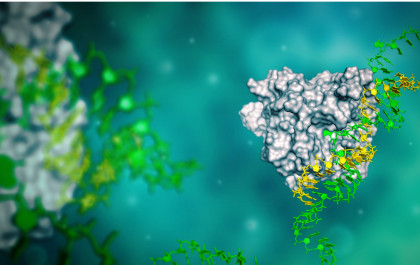Foundation Fighting Blindness will provide up to $7.5 million in funding to develop ProQR’s candidate QR-421a for Usher syndrome type 2A
- Foundation Fighting Blindness and ProQR enter into a partnership to develop QR-421a for Usher syndrome type 2A, targeting mutations in exon 13 of the causative USH2A gene.
- Foundation Fighting Blindness will provide milestone-based co-funding of up to $7.5 million to ProQR to advance the program into the clinic.
- QR-421a received orphan drug designation from the FDA.
- There are currently no therapies commercially available or in clinical development for the vision loss associated with Usher syndrome type 2A.
- QR-421a is part of ProQR’s growing ophthalmology pipeline which also includes lead candidate, QR-110 for Leber’s congenital amaurosis 10 currently in clinical trials, and three additional pipeline programs, QR-411 that addresses another genetic mutation resulting in Usher syndrome type 2A, QRX-1011 for Stargardt’s disease and QRX-504 for Fuchs endothelial corneal dystrophy.
- QR-421a is expected to advance towards the clinic in 2018, with clinical data expected in 2019.
COLUMBIA, Md. and LEIDEN, the Netherlands, Feb. 12, 2018 (GLOBE NEWSWIRE) -- Foundation Fighting Blindness and ProQR Therapeutics N.V. (NASDAQ:PRQR), today announced that they have entered into a partnership to develop QR-421a for Usher syndrome 2A caused by an exon 13 mutation of the causative USH2A gene. Under the agreement, Foundation Fighting Blindness will provide up to $7.5 million in funding to ProQR for the preclinical and clinical development of QR-421a, which is expected to advance towards the clinic in 2018, and safety and efficacy results from the Phase 1/2 trial in Usher syndrome patients are expected in 2019.
Usher syndrome is a devastating genetic disease in which patients first develop hearing loss and then progressive vision loss, thereby threatening their independence and quality of life. Currently there is no treatment for the ophthalmic manifestation of Usher syndrome type 2A. QR-421a is a first-in-class RNA oligonucleotide that is being developed for the treatment of vision loss associated with the disease. QR-421a is designed to modify the RNA such that functional usherin protein is produced in the retina with the goal of stopping the progression of the disease and potentially gaining peripheral vision. ProQR in-licensed the technology underlying QR-421a from Radboud University Medical Center in the Netherlands, where it was invented by lead investigator Dr. Erwin van Wyck.
Foundation Fighting Blindness’ Clinical Research Institute (FFB-CRI) has also launched a natural history study in 120 people with USH2A mutations. The study — known as RUSH2A (“R” stands for “rate of progression”) — was launched in 2017 and is being conducted at about 20 clinical sites around the world. RUSH2A investigators will use a variety of technologies to monitor changes in vision and retinal structure to document and analyze disease progression. Knowledge and data obtained from this trial are intended to provide a better understanding of how USH2A mutations affect the severity and progression of vision loss and help to inform the development of QR-421a.
“Teaming with corporate partners to help promising therapies move through preclinical and clinical development is central to FFB’s strategy so we are very pleased to enter into this partnership with ProQR,” said Benjamin R. Yerxa, PhD, CEO at Foundation Fighting Blindness. “The fact that there are currently no available treatments for Usher syndrome type 2A makes this work that much more exciting and critical.”
QR-421a for Usher syndrome is the second program in ProQR’s growing ophthalmology pipeline scheduled to enter clinical trials. The lead program in the ophthalmology pipeline, QR-110, is currently in a Phase 1/2 safety and efficacy trial in adult and pediatric patients with Leber’s congenital amaurosis 10, due to the p.Cys998X mutation in the CEP290 gene. This pipeline also contains several other molecules for genetic eye diseases, including QR-411 for Usher syndrome type 2A due to the PE-40 mutation, QRX-1011 for Stargardt’s disease and QRX-504 for Fuchs endothelial corneal dystrophy.
“We are excited to team up with the Foundation Fighting Blindness to develop QR-421a for patients that suffer from Usher syndrome due to exon 13 mutations," said Daniel A. de Boer, CEO of ProQR. “They are the leading private funder of retinal disease research with a very patient centric approach which is a core pillar of our strategy. Through this partnership with the Foundation we plan to gain access to important know-how to develop programs in retinal diseases. We expect that the additional funding will allow us to rapidly advance this novel therapy for this orphan disease with a severe unmet need.”
About Foundation Fighting Blindness
The Foundation Fighting Blindness was established in 1971 and has raised more than $725 million for research on preventing, treating and curing blindness caused by inherited retinal diseases. In excess of 10 million Americans, and millions more worldwide, experience or are at risk for vision loss due to retinal degenerations. Through its support of focused and innovative science, and by teaming with industry, the Foundation drives the research that has and will continue to provide treatments and cures for people affected by retinitis pigmentosa, macular degeneration, Usher syndrome and other inherited retinal diseases.
About ProQR
ProQR Therapeutics is dedicated to changing lives through the creation of transformative RNA medicines for the treatment of severe genetic rare diseases such as cystic fibrosis, Leber’s congenital amaurosis 10 and dystrophic epidermolysis bullosa. Based on our unique proprietary RNA repair platform technologies we are growing our pipeline with patients and loved ones in mind.
*Since 2012*
About QR-421a
QR-421a is a first-in-class investigational RNA-based oligonucleotide designed to address the underlying cause of Usher syndrome 2A due to mutations in exon 13 of the USH2A gene. Mutations in this exon can cause loss of functional usherin protein that causes the disease. QR-421a is designed to repair the genetic defect in the RNA in the eye, such that it leads to the expression of a shortened but functional protein, thereby modifying the underlying disease. QR-421a has received orphan drug designation from the U.S. Food and Drug Administration.
About Usher Syndrome Type 2A
Usher syndrome is the leading cause of combined deafness and blindness. Patients with this syndrome generally progress to a stage in which they have very limited central vision and moderate to severe deafness. Usher syndrome type 2A is one of the most common forms of Usher syndrome and is caused by mutations in the USH2A gene. To date, there are no treatments approved or products in clinical development that treat the vision loss associated with Usher syndrome type 2A.
PROQR FORWARD-LOOKING STATEMENTS
This press release contains forward-looking statements. All statements other than statements of historical fact are forward-looking statements, which are often indicated by terms such as “anticipate,” “believe,” “could,” “estimate,” “expect,” “goal,” “intend,” “look forward to”, “may,” “plan,” “potential,” “predict,” “project,” “should,” “will,” “would” and similar expressions. Forward-looking statements are based on management’s beliefs and assumptions and on information available to management only as of the date of this press release. These forward-looking statements include, but are not limited to, statements regarding our collaboration with Foundation Fighting Blindness, including statements regarding the expected funding and benefits of such collaboration, our product candidates QR-110, QRX-1011, QRX-504 and QR-421a, including their clinical development and therapeutic potential, including future development plans. Our actual results could differ materially from those anticipated in these forward-looking statements for many reasons, including, without limitation, risks associated with our clinical development activities, including that positive results observed in our prior and ongoing studies may not be replicated in later trials or guarantee approval of any product candidate by regulatory authorities, that a Fast Track designation by the FDA may not actually lead to a faster development, regulatory review or approval process, and that we may not be able to realize the potential benefits of orphan drug exclusivity, manufacturing processes and facilities, regulatory oversight, product commercialization, intellectual property claims, and the risks, uncertainties and other factors in our filings made with the Securities and Exchange Commission, including certain sections of our annual report filed on Form 20-F. Given these risks, uncertainties and other factors, you should not place undue reliance on these forward-looking statements, and we assume no obligation to update these forward-looking statements, even if new information becomes available in the future, except as required by law.
ProQR Therapeutics N.V.:
Investor and Media Contact:
Bonnie Ortega
T: +1 858 245 3983
ir@proqr.com
Foundation Fighting Blindness:
Media Contact:
Rhea K. Farberman
T: +1 410 423-0635
RFarberman@FightBlindness.org
Sources: ProQR Therapeutics and Foundation Fighting Blindness


